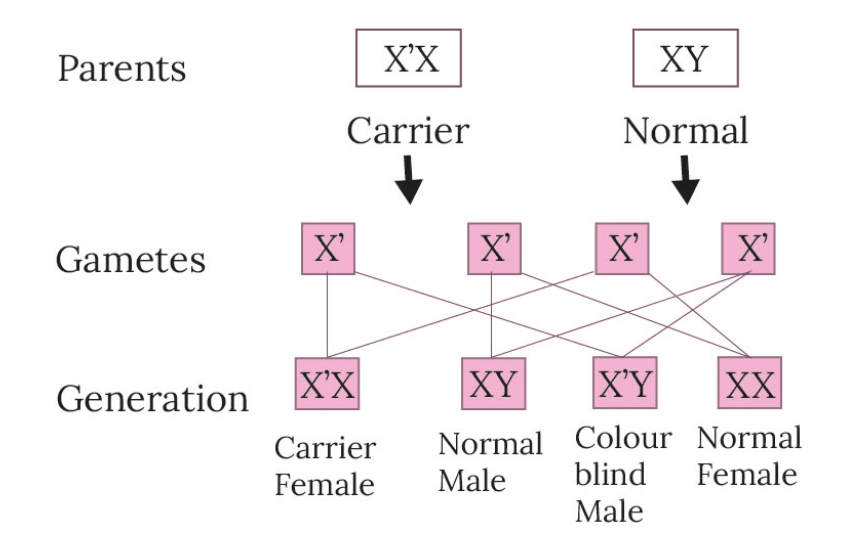
What is the inheritance of color blindness of both parents having normal vision but mother having a recessive gene for color blindness?
A. Son - 50%; Daughter - nil
B. Son -100%; Daughter - nil
C. Son - nil; Daughter - 100%
D. Son - nil; Daughter - nil
Answer
556.2k+ views
Hint: The chromosome responsible for this color blindness is the sex chromosome. Based on the inheritance by pedigree analysis, we can find the chance of getting color blindness from the parents.
Complete answer:
One of the X-linked recessive disorders is color blindness. To cause the disorder (${ X }^{ c }{ Y }$) the affected gene in males of one copy in each cell. To cause the disorder (${ X }^{ c }{ X }^{ c }$) the affected gene in females of two copies in each cell. But the Females with the heterozygous (${ X }^{ c }{ X }$) for this trait act as a normal but serve as a carrier of the disease. By the above question, we can state that the female is a carrier for color blindness (${ X }^{ c }{ X }$) and the father is normal (XY). The carrier mother for color blindness will inherit the disease to 50% sons (${ X }^{ c }{ Y }$) but the daughter will have a normal vision of 100%.
Additional Information: Colour blindness is a hereditary (inherited) condition that is very common. Colour blindness usually passes from parents to the offspring. The sex chromosome is the 23 chromosome in which the color blindness color usually is Red/green color blindness and it is passed from mother to son. The 23 rd chromosome is called a sex chromosome as it helps in determining the sex.
So, the correct answer is ‘Son - 50%; Daughter – nil’.

Note: Most often color blindness is a recessive trait on the X chromosome which is inherited. This is known in genetics as X linked recessive inheritance. Therefore, the disease tends to affect men more than women (8% men, 0.5% women).
Complete answer:
One of the X-linked recessive disorders is color blindness. To cause the disorder (${ X }^{ c }{ Y }$) the affected gene in males of one copy in each cell. To cause the disorder (${ X }^{ c }{ X }^{ c }$) the affected gene in females of two copies in each cell. But the Females with the heterozygous (${ X }^{ c }{ X }$) for this trait act as a normal but serve as a carrier of the disease. By the above question, we can state that the female is a carrier for color blindness (${ X }^{ c }{ X }$) and the father is normal (XY). The carrier mother for color blindness will inherit the disease to 50% sons (${ X }^{ c }{ Y }$) but the daughter will have a normal vision of 100%.
Additional Information: Colour blindness is a hereditary (inherited) condition that is very common. Colour blindness usually passes from parents to the offspring. The sex chromosome is the 23 chromosome in which the color blindness color usually is Red/green color blindness and it is passed from mother to son. The 23 rd chromosome is called a sex chromosome as it helps in determining the sex.
So, the correct answer is ‘Son - 50%; Daughter – nil’.

Note: Most often color blindness is a recessive trait on the X chromosome which is inherited. This is known in genetics as X linked recessive inheritance. Therefore, the disease tends to affect men more than women (8% men, 0.5% women).
Recently Updated Pages
Master Class 12 Business Studies: Engaging Questions & Answers for Success

Master Class 12 Economics: Engaging Questions & Answers for Success

Master Class 12 English: Engaging Questions & Answers for Success

Master Class 12 Maths: Engaging Questions & Answers for Success

Master Class 12 Social Science: Engaging Questions & Answers for Success

Master Class 12 Chemistry: Engaging Questions & Answers for Success

Trending doubts
What are the major means of transport Explain each class 12 social science CBSE

Which are the Top 10 Largest Countries of the World?

Draw a labelled sketch of the human eye class 12 physics CBSE

How much time does it take to bleed after eating p class 12 biology CBSE

Explain sex determination in humans with line diag class 12 biology CBSE

Differentiate between homogeneous and heterogeneous class 12 chemistry CBSE




